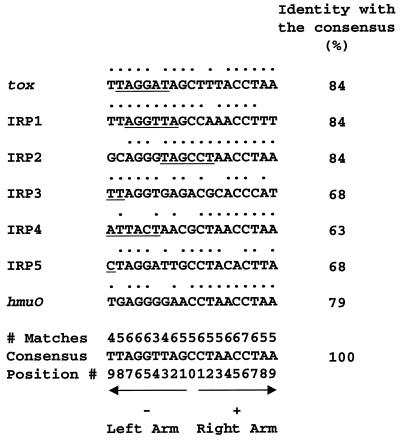FIG. 1.
DtxR-specific operators. Sequences of the message (sense) strands of seven DtxR-specific operators are shown with the 5′-to-3′ orientation from left to right (18, 35, 37). A dot above a nucleotide indicates that it is identical with the corresponding nucleotide in the consensus sequence. The numbers above the consensus sequence indicate how many times matching nucleotides are found at the corresponding positions in these DtxR-specific operators. The left and right arms of the interrupted palindrome are indicated by the leftward- and rightward-pointing arrows, respectively. The central nucleotide is numbered 0, and the nucleotides in the left and right arms of the palindrome are numbered from −1 to −9 and from +1 to 9, respectively, with increasing distance from the center of the operator. Underlining shows the locations of proven or putative promoter regions either within the operators or overlapping them. For the tox, IRP2, IRP3, IRP4, and IRP5 operators, the underlined sequences identify complete or partial −10 promoter regions (18, 19, 37). For the IRP1 operator, the underlined sequence identifies the −35 promoter region (39). For hmuO, the −35 promoter region is immediately contiguous with the 5′ end of the operator, and the −10 promoter region is adjacent to the 3′ end of the operator but separated from it by one intervening nucleotide (35).

